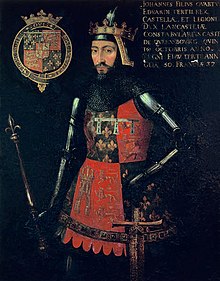This article needs additional citations for verification. (December 2022) |
| John of Gaunt | |
|---|---|
| Duke of Lancaster | |
 A portrait commissioned c. 1593 by Sir Edward Hoby for Queenborough Castle, Kent, probably modelled on Gaunt's tomb effigy in Old St Paul's Cathedral.[1] His tabard shows the royal arms of Castile and León impaling his differenced Plantagenet arms, while on the shield Castile and León is shown as an inescutcheon of pretence, representing his claim to that kingdom by right of marriage to Constance of Castile. | |
| Duke of Aquitaine | |
| Reign | 2 March 1390 – 3 February 1399 |
| Predecessor | Richard II |
| King of Castile | |
| Claimed | 29 January 1372 – 8 July 1388 |
| Born | 6 March 1340 Saint Bavo's Abbey, Ghent, Flanders |
| Died | 3 February 1399 (aged 58) Leicester Castle, Leicestershire, Kingdom of England |
| Burial | 15 March 1399 St Paul's Cathedral, London, remains now lost |
| Spouses | |
| Issue more... | |
| House |
|
| Father | Edward III of England |
| Mother | Philippa of Hainault |
| Military career | |
| Allegiance | |
| Service | 1367–1388 |
| Conflicts |
|

John of Gaunt, Duke of Lancaster (6 March 1340 – 3 February 1399) was an English royal prince, military leader, and statesman. He was the fourth son (third surviving) of King Edward III of England, and the father of King Henry IV. Because of Gaunt's royal origin, advantageous marriages, and some generous land grants, he was one of the richest men of his era, and was an influential figure during the reigns of both his father and his nephew, Richard II.[2][3] As Duke of Lancaster, he is the founder of the royal House of Lancaster, whose members would ascend the throne after his death. His birthplace, Ghent in Flanders, then known in English as Gaunt, was the origin of his name.
John's early career was spent in France and Spain fighting in the Hundred Years' War. He made an abortive attempt to enforce a claim to the Crown of Castile that came through his second wife, Constance of Castile, and for a time styled himself as King of Castile. When Edward the Black Prince, Gaunt's elder brother and heir-apparent to the ageing Edward III, became incapacitated owing to poor health, Gaunt assumed control of many government functions, and rose to become one of the most powerful political figures in England. He was faced with military difficulties abroad and political divisions at home, and disagreements as to how to deal with these crises led to tensions between Gaunt, the English Parliament, and the ruling class, making him an extremely unpopular figure for a time.
John exercised great influence over the English throne during the minority of King Richard II (Edward the Black Prince's son) and the ensuing periods of political strife. He mediated between the king and a group of rebellious nobles, which included Gaunt's own son and heir-apparent, Henry Bolingbroke.[4] Following Gaunt's death in 1399, his estates and titles were declared forfeit to the Crown, and his son Bolingbroke, now disinherited, was branded a traitor and exiled.[5] Henry returned from exile shortly after to reclaim his inheritance, and deposed Richard. He reigned as King Henry IV of England (1399–1413), the first of the descendants of John of Gaunt to hold the English throne.
All English monarchs from Henry IV onwards are descended from John of Gaunt. His direct male line, the House of Lancaster, would rule England from 1399 until the time of the Wars of the Roses. Gaunt is also generally believed to have fathered five children outside marriage: one early in life by a lady-in-waiting to his mother;[citation needed] the others, surnamed Beaufort, by Katherine Swynford, his long-term mistress and third wife. They were later legitimised by royal and papal decrees, but this did not affect Henry IV's bar to their having a place in the line of succession. Through his daughter Joan Beaufort, Countess of Westmorland, he was an ancestor of the Yorkist kings Edward IV, Edward V and Richard III. Through his great-granddaughter Lady Margaret Beaufort he was also an ancestor of Henry VII, who married Edward IV's daughter Elizabeth of York, and all subsequent monarchs are descendants of their marriage. Two of John's daughters married into continental royal houses (those of Portugal and Castile). Through them, many royal families of Europe can trace lineage to him.
- ^ Harris 2010, p. 16.
- ^ Death of John of Gaunt, Richard Cavendish explains the life and death of Henry IV's father, on February 3rd, 1399
- ^ John of Gaunt: Son of One King, Father of Another, Kathryn Warner, Amberley Publishing, 2022
- ^ "John of Gaunt, duke of Lancaster". Britannica.com. 21 March 1999.
- ^ Given-Wilson, Chris, ed. (2005). "Richard II: September 1397". British History Online. Parliament Rolls of Medieval England. Ass. ed. by Paul Brand, J. R. S. Phillips, Mark Ormrod, Geoffrey Martin, Anne Curry, & Rosemary Horrox. Retrieved 8 June 2013.